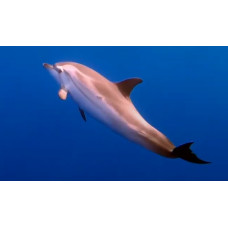Latin name
Stenella coeruleoalba
Other names
Euphrosyne dolphin
Identification
It is distinguished from other dolphins by the presence of lateral stripes. It has a slender body with a long dark beak, a narrow forehead and a smooth slope, with a distinct fold separating the forehead from the beak.
Features of fish fins
The dorsal fin is curved and the flippers are small and thin with pointed tips.
Fish colouring
The underside is white, bluish or pink. One or two black stripes surround the eyes and run down the back to the fin. These stripes are the same width as the fin. Two more black stripes run behind the ear - one is short and ends just above the fin. The other is longer and thicker along the sides until it curls under the belly just before the base of the tail. Above these stripes, the dolphin's sides are light blue or grey. All appendages are also black.
Distribution
It inhabits temperate or tropical coastal waters. It is common in the North and South Atlantic, including the Mediterranean, and sightings have been reported in the Sea of Marmara and the Gulf of Mexico, the Indian Ocean and the Pacific Ocean.
Habitat
Has been found in water temperatures between 10 and 26°C, although the standard range is 18-22°C.
Size
At birth, individuals weigh about 10 kg (22 lb) and reach one metre (3 ft) in length. By adulthood, they grow to 2.4 m (females) or 2.6 m (males) and weigh 150 kg (330 lb) (female) or 160 kg (352 lb) (male). Life expectancy is about 55-60 years.
Behavior
Travels in large groups, usually up to thousands of individuals. Groups may be smaller in the Mediterranean and Atlantic. They can also mix with common dolphins. Like all dolphins, striped dolphins can perform acrobatic tricks - often overcoming obstacles and jumping well above the water's surface.
Food and feeding habits
They feed on fish, krill, octopus and squid. Mediterranean dolphins appear to feed mainly on cephalopod molluscs (50-100% of stomach contents), while north-east Atlantic dolphins mostly prey on fish, usually cod. They can dive to depths of up to 700m to hunt deeper dwellers.
Reproduction
Mediterranean females reach sexual maturity at 12 years and Pacific females at seven to nine years. Pregnancy lasts about 12 months with a three to four year interval between calves.
Fishing
Before the introduction of quotas, it suffered from Japanese fishing, now it suffers from nets, noise and pollution (Mediterranean population). The total population of striped dolphins exceeds 2 million individuals.
Human interaction
Good for training, taking food from hands, jumping through a hoop.
| Classification | |
| Phylum | Chordata |
| Class | Mammalia |
| Squad | Artiodactyla |
| Family | Delphinidae |
| Genus | Stenella |
| Species | S. coeruleoalba |
| Features | |
| Conservation status | Least Concern |
| Habitat | Pelagic |
| Life span, years | 60 |
| Maximum body weight, kg | 160 |
| Maximum length, cm | 260 |
| Sailing speed, m/s | No information |
| Threat to people | Not edible |
| Way of eating | Predator |
Striped dolphin
Tags: striped dolphin


